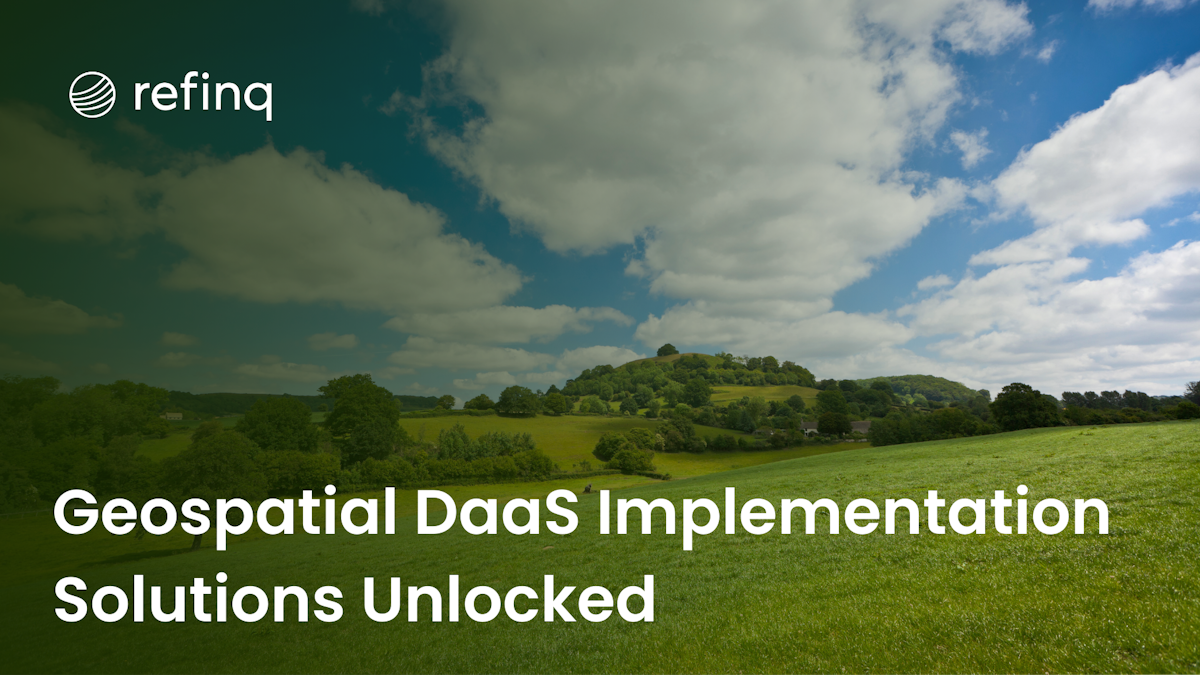Solving Geospatial DaaS Implementation Problems

Geospatial Data as a Service (DaaS) has become a game-changer for businesses looking to leverage location-based insights. By providing on-demand access to geospatial data and analytics, companies can make informed decisions that drive growth and efficiency. However, implementing Geospatial DaaS comes with its own set of challenges. (Learn about geospatial data integration challenges). Platforms like refinq are pioneering solutions that help enterprises navigate these challenges by offering advanced climate and biodiversity risk assessments. (Discover how refinq empowers businesses).
Navigating Challenges in Geospatial DaaS Implementation
Understanding Geospatial DaaS
Geospatial DaaS is a cloud-based service that delivers geospatial data and processing capabilities over the internet. It allows organizations to access vast amounts of location-based data without the need for significant infrastructure investment. (Read about delivering value with Geospatial DaaS).
Common Implementation Challenges
Data Integration Issues
Integrating geospatial data with existing systems can be complex due to differing data formats and standards.
Solution: Use standardized data formats like GeoJSON and APIs that facilitate seamless integration. (Explore strategies to conquer GIS implementation challenges).
Data Quality and Accuracy
Inaccurate or outdated data can lead to flawed analyses and decisions.
Solution: Implement data validation protocols and partner with reputable data providers to ensure high-quality data.
Scalability Concerns
As data volume grows, maintaining performance becomes challenging.
Solution: Utilize scalable cloud services that can handle increasing data loads without compromising speed.
Security and Compliance
Protecting sensitive geospatial data is crucial, especially when dealing with personal or proprietary information.
Solution: Employ robust encryption methods and comply with regulations like GDPR and CCPA. (Learn about geospatial data management best practices).
Technical Expertise
Lack of skilled personnel can hinder effective implementation.
Solution: Invest in training or collaborate with experts in geospatial technologies.
Overcoming Data Integration Challenges
Embracing Standardization
Use Common Data Formats: Adopting formats like GeoTIFF and Shapefiles facilitates easier data exchange.
APIs and Web Services: Leverage APIs to connect different systems seamlessly.
Data Transformation Tools
Utilize ETL (Extract, Transform, Load) tools specifically designed for geospatial data to streamline integration processes. (Discover opportunities and challenges in geospatial technologies).
Ensuring Data Quality and Accuracy
Implementing Data Validation
Automated Checks: Use software to automatically verify data accuracy.
Regular Updates: Ensure data is refreshed regularly to maintain relevance.
Partnering with Trusted Providers
Collaborate with reputable Geospatial DaaS providers known for high data integrity. (Read about delivering value with Geospatial DaaS).
Addressing Scalability and Performance
Cloud-Based Solutions
Scalable Infrastructure: Opt for cloud services that can dynamically allocate resources based on demand.
Load Balancing: Implement load balancers to distribute workloads efficiently.
Optimization Techniques
Data Compression: Reduce data size without losing quality to improve processing times.
Indexing and Caching: Use spatial indexing and caching mechanisms to speed up data retrieval.
Enhancing Security and Compliance
Robust Security Measures
Encryption: Encrypt data both at rest and in transit.
Access Control: Implement role-based access controls to restrict data access.
Compliance Management
Stay updated with regional and international regulations regarding data privacy and protection. (Learn about challenges in geospatial data).
Building Technical Expertise
Training and Development
Workshops and Seminars: Attend industry events to stay current with geospatial technologies.
Certification Programs: Encourage team members to obtain certifications in GIS and related fields.
Collaboration with Experts
Partner with consultants or firms specializing in Geospatial DaaS implementation.
How refinq Enhances Geospatial DaaS Implementation
refinq is at the forefront of addressing Geospatial DaaS implementation challenges by offering advanced, user-friendly tools for environmental risk assessment. By processing over 2.5 billion data points from earth observations and climate models, refinq provides comprehensive risk profiles with up to 25-meter granularity for any global location. (Explore refinq's climate solutions).
Benefits of Using refinq
Seamless Data Integration: refinq's platform is designed to integrate effortlessly with existing systems, minimizing technical hurdles.
High-Quality Data: By utilizing machine learning and geospatial analysis, refinq ensures accurate and up-to-date data.
Scalable Solutions: The cloud-based platform can handle growing data needs without compromising performance.
Security and Compliance: refinq aligns with international disclosure frameworks like TNFD, CSRD, ESRS, and SBTN, ensuring regulatory compliance.
Actionable Insights: Translates complex environmental data into strategies for navigating nature-related risks, helping businesses develop sustainable, nature-positive initiatives. (Discover refinq's biodiversity solutions).
By integrating refinq into their operations, businesses can overcome common Geospatial DaaS implementation challenges and leverage location-based insights effectively.
Conclusion
Implementing Geospatial DaaS presents several challenges, from data integration and quality to scalability and security. By understanding these hurdles and employing strategic solutions, businesses can successfully navigate the complexities of geospatial data implementation. Platforms like refinq play a crucial role in this landscape, offering advanced tools and expertise that address these challenges head-on. Embracing such solutions not only streamlines implementation but also empowers organizations to make data-driven decisions that foster growth and sustainability.
Relevant Links
Strategies to Conquer GIS Implementation Challenges (SpyroSoft)
Opportunities and Challenges in Using Geospatial Technologies for Education (ResearchGate)
Guest Talk on Geospatial Data Challenges and Solutions (FAO)